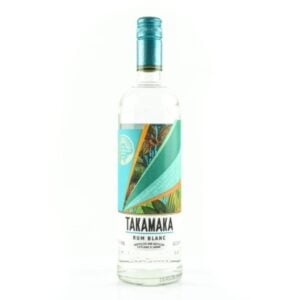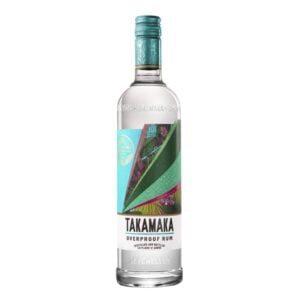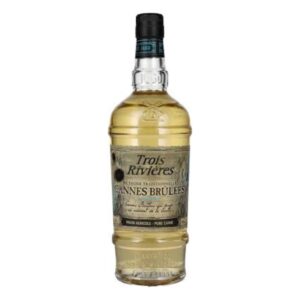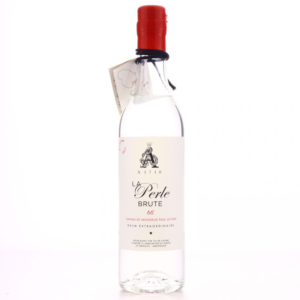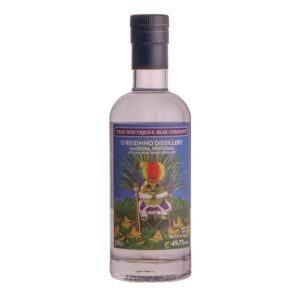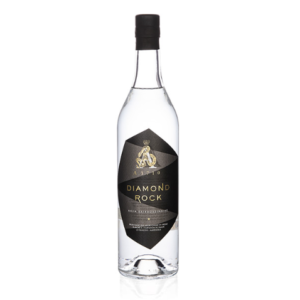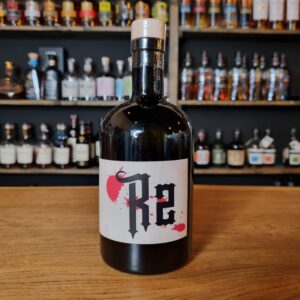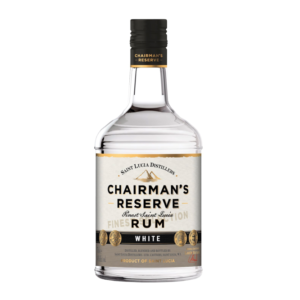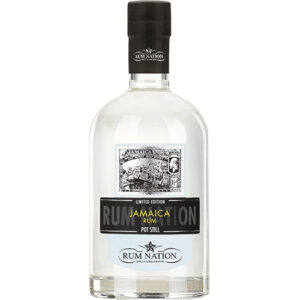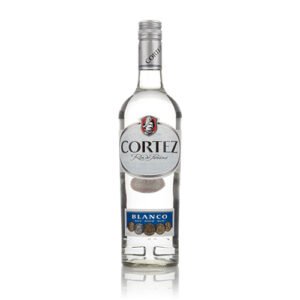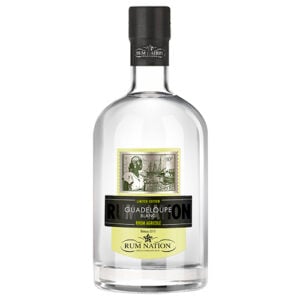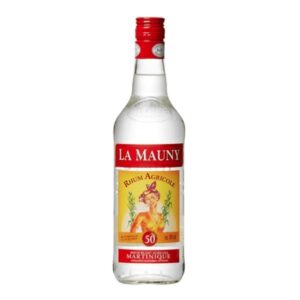Showing all 12 resultsSorted by popularity
White Rum – The Complete Guide
TL;DR: In Short
- White rum is characterized by its clear appearance, light body, and sweet, subtle flavor profile
- Primarily made from sugarcane byproducts (molasses or cane juice) and defined by minimal aging or charcoal filtering
- Found in several styles, including Spanish-style (lighter), French-style (grassy), and English-style (fuller-bodied)
- Best enjoyed in refreshing cocktails like Daiquiris or Mojitos, or as a lighter spirit in tropical mixed drinks
Disclaimer: This guide is intended for informational purposes for adults over 18 years of age. Vault of Spirits encourages responsible alcohol consumption.
Introduction to White Rum
White rum has a rich history and fascinating craftsmanship behind it. From its origins in the Caribbean to its global popularity today, this spirit has evolved to become one of the world’s most appreciated distilled beverages.
This guide provides insight into the production, flavor notes, and enjoyment of white rum, whether you’re a beginner or seasoned enthusiast.
Often underestimated compared to its aged counterparts, white rum offers remarkable versatility and a clean canvas for cocktails, while also showcasing the true character of the base ingredients without the influence of extended barrel aging.
How Did White Rum Originate?
From Past to Present
White rum’s story begins in the 17th century Caribbean, where sugar plantation workers discovered that molasses, a byproduct of sugar processing, could be fermented and distilled into alcohol.
The earliest rums were likely unaged and consumed shortly after distillation, making them the predecessors of modern white rum.
Initially considered a low-quality spirit or “kill-devil,” rum gradually gained respectability, with production techniques evolving through the 18th and 19th centuries.
The development of column stills in the 19th century enabled producers to create lighter, cleaner spirits that would later become the foundation for white rum as we know it today.
Which Historical Milestones Have Shaped White Rum?
Prohibition in the United States (1920-1933) inadvertently boosted Caribbean rum production, with Cuba becoming a hotspot for Americans seeking legal alcohol.
This era saw the rise of legendary bartenders like Constante Ribalaigua, who perfected classics like the Daiquiri using white rum at El Floridita in Havana.
The Cuban Revolution in 1959 led to the exile of many Cuban rum makers, spreading production techniques throughout the Caribbean and beyond.
Modern filtration methods developed in the mid-20th century allowed producers to create crystal-clear rums without sacrificing flavor complexity, revolutionizing the category.
How Has White Rum Influenced Cultural Traditions?
In the Caribbean, rum has been fundamental to cultural identity, with white rum often used in religious ceremonies, celebrations, and as a traditional medicine.
The rum ration in the British Royal Navy, which lasted until 1970, frequently used unaged or lightly aged rum, contributing to its spread throughout colonial territories.
White rum became a symbol of tropical leisure during the mid-20th century Tiki movement, cementing its association with vacation and escapism in Western culture.
Today, white rum continues to play an important role in Caribbean festivals and celebrations, from Carnival to Junkanoo, representing heritage and tradition.
Why Is White Rum Popular Today?
White rum’s clean profile makes it an exceptionally versatile cocktail ingredient, especially in today’s craft cocktail renaissance where bartenders value adaptability.
The spirit’s approachable flavor profile appeals to new spirits drinkers, serving as an entry point to the broader rum category.
Growing interest in authentic cocktails has led to increased appreciation for quality white rums that offer more character than mass-produced varieties.
The explosion of premium and craft white rums has elevated the category beyond its reputation as merely a mixing spirit, with connoisseurs now appreciating it for sipping as well.
How Is White Rum Produced?
Which Raw Materials Are Used in Production?
White rum production begins with sugarcane derivatives, each imparting unique characteristics to the final spirit.
The choice of base material significantly influences the rum’s character before distillation even begins.
Different producers select their raw materials based on regional traditions, availability, and desired flavor profiles.
Primary ingredients:
- Molasses – The most common base, this thick, dark sugarcane byproduct contributes rich, caramelized notes
- Sugarcane juice – Used primarily in agricole-style rums, offering grassy, vegetal qualities and terroir expression
- Sugarcane syrup – A concentrated form of cane juice that provides balanced sweetness and complexity
How Does the Fermentation Process Work?
Fermentation begins when yeast is introduced to a diluted sugar solution, converting sugars into alcohol and carbon dioxide.
The type of yeast used dramatically affects flavor development—wild yeasts create funky, complex profiles while cultured yeasts offer consistency and specific flavor characteristics.
Fermentation duration varies widely: shorter periods (24-48 hours) produce lighter rums, while longer fermentations (up to two weeks) develop more complex flavor compounds.
Temperature control during fermentation is crucial, with most producers maintaining conditions between 75-95°F (24-35°C) to balance fermentation speed with flavor development.
Which Distillation Techniques Are Used?
Distillation separates alcohol from the fermented wash, concentrating both alcohol content and flavors.
The distillation method significantly impacts the character of white rum, determining its body, intensity, and aromatic profile.
Common distillation methods:
- Pot still distillation – Creates fuller-bodied rums with more congeners and flavor compounds, typical in English-style production
- Column still distillation – Produces lighter, cleaner rums with higher alcohol content, common in Spanish-style production
- Hybrid approaches – Many producers use both methods, blending the results to achieve specific flavor profiles
What Is the Significance of Aging?
Unlike aged rums, white rum undergoes minimal or no aging to maintain its clear appearance and bright flavor profile.
When aging does occur, it’s typically brief—from a few months to under two years—in neutral containers or previously used barrels that impart minimal color.
Many white rums are filtered through activated charcoal after brief aging to remove any color and some heavier compounds, resulting in a crystal-clear appearance.
Some premium white rums are actually aged for several years and then extensively filtered to remove color while retaining complexity—these are sometimes called “aged white rums.”
Which Regions Are Known for White Rum?
Where Are the Best Varieties Produced?
The Caribbean remains the epicenter of white rum production, with each island developing distinctive styles.
Cuba is revered for light, clean white rums with subtle complexity, setting the standard for the Spanish style.
Puerto Rico produces precisely crafted white rums that balance smoothness with character, following strict quality regulations.
Martinique and Guadeloupe specialize in rhum agricole blanc, made from fresh sugarcane juice rather than molasses, offering grassy, vegetal profiles.
Jamaica, though better known for fuller-bodied aged rums, produces some outstanding white rums with more robust flavor profiles and signature “funk.”
How Do Geography and Climate Affect the Flavor?
Tropical climates accelerate both fermentation and aging processes, creating more rapid flavor development even in briefly aged white rums.
Coastal production facilities expose fermenting wash to native yeasts and ocean air, contributing subtle saline notes to some white rums.
Soil conditions affect sugarcane quality and composition, which translates to the final spirit—particularly evident in agricole rums made from fresh cane juice.
Water sources introduce unique mineral profiles that influence fermentation and the final product’s mouthfeel and flavor nuances.
What New Trends Are Seen in White Rum Production?
Craft distillers are experimenting with heirloom sugarcane varieties to create white rums with distinct terroir and flavor profiles.
Extended fermentation times using indigenous yeasts are gaining popularity, producing more complex and character-driven white rums.
Cross-category innovations, such as using wine yeasts or beer brewing techniques, are creating new expressions that challenge traditional boundaries.
Transparency in production methods and ingredients is becoming increasingly important to consumers, with producers highlighting their authentic processes.
What Do the Different Quality Designations Mean?
“Silver” or “Plata” typically indicates a white rum that has been briefly aged then filtered.
“White” or “Blanco” generally refers to unaged or minimally aged rum that maintains its clear appearance naturally or through filtration.
“Premium” white rums often undergo more meticulous production processes, including longer fermentation and careful distillation.
Geographical indications, like “Rhum Agricole AOC Martinique,” guarantee specific production methods and regional authenticity.
How Does White Rum Taste?
What Characterizes the Typical Flavor Profile?
White rum typically showcases bright, clean flavors with moderate sweetness and subtle complexity.
The mouthfeel ranges from light and crisp in column-distilled varieties to richer and more textured in pot-distilled expressions.
Typical aromatic and flavor notes vary by production style and region, but most white rums share certain characteristics.
Typical aromas:
- Sweet notes – Vanilla, marshmallow, cotton candy, subtle caramel
- Fruit elements – Banana, coconut, citrus peel, tropical fruits
- Base characteristics – Subtle molasses, grassiness (especially in agricole), light floral hints
How Does the Flavor Vary Between Different Styles?
Spanish-style white rums (from Cuba, Puerto Rico, Dominican Republic) offer clean, light profiles with subtle sweetness and minimal congeners.
French-style white rums (rhum agricole from Martinique, Guadeloupe) present grassy, vegetal characteristics with pronounced terroir and vibrant complexity.
English-style white rums (from Jamaica, Barbados, Guyana) deliver fuller bodies with more pronounced flavor intensity, often with tropical fruit notes and subtle funk.
Modern craft white rums frequently blend traditional approaches with innovative techniques, creating unique hybrid styles that defy traditional categorization.
How Does the Flavor Develop with Age?
While white rum is typically unaged or briefly aged, some producers do age their spirit before filtration, creating subtle complexity.
Brief aging (a few months) can round out harsher notes without adding significant barrel character or color.
Filtered aged white rums (aged 1-3 years then filtered) retain more complex flavor compounds while maintaining their clear appearance.
Extended cask resting in neutral containers can develop subtle depth without introducing traditional barrel notes of vanilla and spice.
What Signs Reveal High Quality?
Superior white rums display balanced sweetness without cloying artificial notes or harsh alcoholic heat.
Texture and mouthfeel indicate quality—premium white rums offer silky smoothness rather than thin or watery consistency.
Complexity and development on the palate, rather than a flat one-dimensional profile, suggest more careful production methods.
A clean, pleasant finish that leaves subtle flavor echoes rather than a harsh aftertaste indicates proper distillation and filtration.
How Is White Rum Best Enjoyed?
What Is the Optimal Serving Method?
Quality white rums can be appreciated neat at room temperature to fully assess their subtle complexities.
A single large ice cube provides gentle cooling without excessive dilution for casual sipping.
White rum excels in cocktails, where its clean profile allows it to complement rather than overpower other ingredients.
For mixed drinks, white rum works beautifully with fresh citrus juices, tropical fruits, and aromatic herbs like mint.
Which Glass and Temperature Are Ideal?
A tulip-shaped nosing glass concentrates aromas for serious tasting sessions of premium white rums.
For casual sipping, a rocks glass accommodates ice while still capturing sufficient aromatics.
When enjoying white rum neat, slight chilling to about 60-65°F (15-18°C) can enhance refreshing qualities without muting flavors.
For cocktails, properly chilled glassware—whether a coupe, highball, or collins glass—helps maintain the ideal serving temperature.
How Do You Taste Like an Expert?
Begin by examining the rum’s clarity and viscosity, noting any subtle tinting or legs that form on the glass.
Approach aromas gradually—first from a distance, then with gentle sniffs to detect volatile compounds without overwhelming your senses.
When tasting, allow the rum to coat your entire palate before swallowing, noting the progression from initial impression through mid-palate to finish.
Consider the rum’s structural elements: sweetness level, acidity, body weight, and texture, as well as specific flavor notes.
Which Dishes Complement White Rum?
Seafood dishes, especially ceviche and grilled fish, pair beautifully with the clean profile of white rum.
Tropical fruits like mango, pineapple, and coconut echo flavors often found in the spirit itself.
Spicy cuisines, from Caribbean jerk to Thai curries, find balance with white rum’s subtle sweetness.
Light desserts featuring citrus or tropical flavors create harmonious pairing experiences, especially with slightly sweeter white rums.
Which Cocktails Can Be Made with White Rum?
Which Classic Cocktails Should You Know?
The world of white rum cocktails features several timeless classics that have stood the test of time.
Daiquiri
Ingredients: 2 oz white rum, 3/4 oz fresh lime juice, 1/2 oz simple syrup
Preparation: Shake all ingredients with ice and strain into a chilled coupe glass
History: Created in Cuba around 1900, named after the mining town where it originated; popularized by Ernest Hemingway
Mojito
Ingredients: 2 oz white rum, 1 oz fresh lime juice, 2 tsp sugar, 6-8 mint leaves, soda water
Preparation: Muddle mint with sugar and lime juice, add rum and ice, top with soda water
History: Evolved from the “El Draque” created in the 16th century; became Cuba’s national drink
Which Modern Cocktails Are Worth Trying?
The White Negroni Daiquiri combines 1.5 oz white rum, 3/4 oz Suze, 3/4 oz Lillet Blanc, and 1/2 oz lime juice for a contemporary bitter-sweet experience.
The Kingston Club mixes 2 oz white rum with 3/4 oz lime juice, 1/2 oz green tea syrup, and a dash of Angostura bitters for a refreshing twist.
The Tropical Spritz features 1 oz white rum, 1/2 oz passion fruit liqueur, 1/4 oz lime juice, topped with sparkling wine and soda for an elegant aperitif.
The Rum Espresso Martini substitutes white rum for vodka in the classic formula, adding tropical notes to the coffee cocktail.
How Is White Rum Enjoyed Neat?
Premium white rums can be sipped neat at slightly below room temperature to appreciate their subtle complexities.
A simple preparation with a large ice cube and a lime wedge allows the rum’s character to shine through with minimal dilution.
White rum and coconut water makes for a refreshing, simple drink that highlights the spirit’s tropical connection.
In many Caribbean countries, white rum is enjoyed with a splash of water or on the rocks as an everyday sipper.
Which Homemade Variants Can You Experiment With?
Fruit-infused white rums can be created by soaking fresh pineapple, mango, or strawberries in the spirit for 3-5 days.
Herb-infused variations using mint, basil, or lemongrass add aromatic complexity to white rum within just 24 hours.
Spice infusions with vanilla beans, cinnamon sticks, or star anise create warming profiles perfect for cooler months.
Home blending of different white rums allows you to create custom profiles that combine the best characteristics of various styles.
What Should You Know Before Buying White Rum?
Which Details Should You Pay Attention to When Buying?
Check for the term “pure rum” or “traditional rum” on the label, which generally indicates no added flavors or excessive sweeteners.
Look for information about distillation method—pot still rums will typically offer more character than those exclusively column distilled.
Production location matters—different Caribbean islands and regions have distinctive rum-making traditions that influence the final product.
Alcohol percentage can indicate style; lower ABV (40%) often suggests a lighter style, while higher proof (45%+) may offer more complexity and intensity.
What Do You Get for Your Money in Different Price Ranges?
Entry-level white rums ($15-20) provide clean profiles suitable for mixing in casual cocktails but may lack complexity for sipping.
Mid-range options ($20-35) offer improved balance and character, with more distinctive regional traits and better production quality.
Premium white rums ($35-60) deliver notable complexity, distinctive character, and often showcase traditional production methods worth exploring neat.
Super-premium expressions ($60+) represent the height of craftsmanship, offering exceptional balance, texture, and flavor development that rivals aged spirits.
How Is White Rum Properly Stored?
Unlike aged rum, white rum doesn’t continue to develop in the bottle, so extremely long-term storage offers no advantages.
Store bottles upright to minimize contact between the spirit and the closure, preventing potential contamination.
Keep away from direct sunlight and excessive heat, which can gradually alter flavors over time.
Once opened, white rum maintains its quality well for 1-2 years, though the flavor may gradually diminish after extended exposure to air.
Is White Rum a Good Investment?
Unlike aged spirits, most white rums aren’t considered investment-grade collectibles due to their unaged nature.
Limited edition releases from prestigious distilleries occasionally appreciate in value, particularly those with historical significance.
Discontinued expressions from iconic producers can become sought-after by collectors, especially those representing traditional production methods.
For most consumers, white rum is best viewed as an investment in quality drinking experiences rather than financial appreciation.
Which Brands Do We Recommend?
What’s Best for Beginners?
Havana Club 3 Year Old (Cuban) offers an excellent introduction to traditional white rum with subtle complexity and a clean finish.
Plantation 3 Stars blends rums from Barbados, Jamaica, and Trinidad, providing a versatile entry point to different Caribbean styles.
El Dorado 3 Year White showcases Guyanese rum character with light body and surprising complexity at an approachable price.
Don Q Cristal from Puerto Rico delivers a clean, balanced profile perfect for classic cocktails while being gentle on the wallet.
What Will Impress Enthusiasts?
Clairin Sajous from Haiti offers an unfiltered, terroir-driven expression with incredible complexity and traditional production methods.
Probitas (or Veritas in some markets) combines Jamaican and Barbadian rums for a sophisticated mixing white rum that also excels neat.
Rhum J.M Blanc from Martinique presents an exemplary agricole style with grassy notes, vibrant character, and distinctive terroir.
Rum Fire from Hampden Estate delivers Jamaica’s signature “funk” in unaged form, showcasing traditional high-ester distillation.
Which Bottles Are Most Sought After?
Neisson L’Esprit Blanc 70° offers the agricole experience at higher proof (70% ABV), delivering exceptional intensity and complexity.
Rum Bar Silver Overproof from Worthy Park Estate provides authentic Jamaican pot still character at a powerful 63% ABV.
Foursquare Probitas/Veritas has become a modern classic, showcasing Mark Reynier’s blending expertise across different distilleries.
Wray & Nephew White Overproof remains an iconic Jamaican expression with cultural significance and mixological versatility.
Where Do You Get the Most for Your Money?
Probitas/Veritas delivers exceptional quality at around $30, outperforming many rums at twice the price.
Rhum J.M Blanc 55° offers authentic agricole character and versatility around $35, representing excellent value for this style.
Worthy Park Rum-Bar Silver provides authentic Jamaican pot still character at approximately $25, ideal for exploring this distinctive style.
Denizen 3 Year White Rum blends Caribbean rums into a versatile, characterful product that excels in cocktails at about $20.
Frequently Asked Questions
What Is White Rum?
White rum is a clear spirit distilled from fermented sugarcane byproducts (typically molasses or cane juice).
It’s either unaged or briefly aged, then often filtered to remove any color, resulting in a crystal-clear appearance.
White rum showcases the pure expression of its base ingredients without the significant influence of oak aging.
How Is White Rum Produced?
Production begins with fermenting sugarcane derivatives (molasses or cane juice) with water and yeast.
The fermented wash is then distilled using pot stills, column stills, or a combination of both methods.
After distillation, the spirit is either bottled immediately or rested briefly in neutral vessels before filtration and bottling.
What Characterizes White Rum?
White rum typically displays bright, clean flavors with notes of subtle sweetness, tropical fruit, and light grassiness.
Its clear appearance distinguishes it from aged rum varieties that take on amber colors from barrel aging.
The spirit ranges from light and crisp to more robust and flavorful, depending on the production methods and regional style.
Where Can You Buy White Rum?
White rum is widely available at most liquor retailers, from specialty spirits shops to general liquor stores.
Online retailers offer extensive selections, often including craft and international brands that may be difficult to find locally.
Specialty rum shops in major cities provide curated collections with staff who can guide you to quality options based on your preferences.
